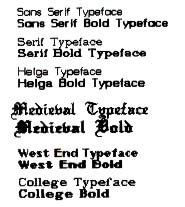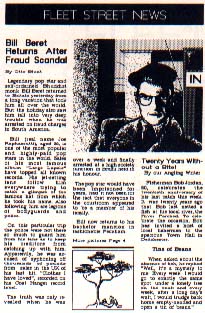THE
FLEET STREET
DESKTOP PUBLISHER
THE ST DESKTOP PUBLISHING
BOOM CONTINUES
by Charles F. Johnson
Desktop publishing on the Atari ST is heating up. Fleet Street Publisher, from the British company Mirrorsoft, promises to bring real publishing power to the ST at an attractive price.
The program, which is distributed in the United States by Spectrum Holobyte is completely GEM-based, using standard windows, drop-down menus, and dialog boxes. It lets you construct multi-page documents easily, using a variety of typefaces and type styles, and include pictures or illustrations, then print them with a dot-matrix printer. Overall, Fleet Street Publisher is a polished program with some very powerful features, some of which are not present in any other desktop publishing software for the ST.
WHAT YOU SEE IS WHAT YOU GET
Fleet Street, like most newer word processors and desktop publishing programs, follows the what-you-see-is-what-you-get principle. When you are working on a document, the screen always displays approximately what the finished, printed product will look like. For instance, as you type text, Fleet Street constantly adjusts the display according to the text settings in effect. If you include graphics in your document, you can see the pictures as you work, so you know exactly what you're creating.
The first desktop publishing programs for microcomputers were really just for doing page layout-you'd start with text prepared on a regular word processor and pictures from a digitizer or drawing program, and then assemble them into your final pages. Fleet Street is part of the next generation: It lets you compose your words while you're using Fleet Street, and even includes a simple drawing facility for graphics.
When you begin using Fleet Street, it functions as a rather limited word processor with standard word processing functions. The search and replace lets you search for strings of text backward and forward, and you may specify whether to ignore differences in upper and lower case. You do all your work in regular GEM windows; you may have several text windows with different documents open at the same time, and cut and paste text among them.
Fleet Street will read in ASCII text files created with other text editors and word processors. It won't actually convert files from non-ASCII formats, though. For example, to use First Word and Word Writer ST files you must save them in ASCII format first, and ST Writer files must be printed to disk.
Once you've created or loaded your text, Fleet Street lets you create a special document called a page, complete with columns, borders, headlines and illustrations. You can specify where in each page your text goes, in columns and partial columns. You can also link the columns together so that text automatically flows into the correct columns as you type.
A FONT OF FONTS
One of Fleet Street's real pluses is its good selection of fonts (see Figure 1). There are six different typefaces included with the program (and you can substitute other GDOS fonts for the six default faces). Fleet Street offers only a few different type styles--normal, bold, italics and underlined, and combinations of those features. It supports point sizes from 4 to 72, and there are other fine tuning controls for typefaces as well.
The first time you use a font, you must load it from the Fonts disk. That takes time--and it takes even more time for the program to convert the font to the proper size and style. It's a long wait compared to a regular word processor. Fortunately, once you've used a typeface it's stored in memory, so the next time you use it it's available almost immediately.
Fleet Street supports eight different units of measurement: points, picas, inches, centimeters, millimeters, percentage of current point size, relative units of current point size, and absolute units (1/10 of a point). You may never need to use some of those units, but it's nice to know that Fleet Street has such flexible measurement capabilities. You can usually choose which units you want to use for each specifications--so, for instance, you can choose your type size in points and your page size in inches.
While editing a document, you may display rulers along the top and left sides of the current window, and the rulers can be in any of the available unit systems. As you move the mouse cursor within the window, little marks indicate its position on both rulers--quite handy for making accurate measurements.
PICTURES, TOO
Fleet Street has a very limited drawing facility. It offers only two options: draw and erase. There are no commands to create circles, ellipses, or connected lines, functions found in most ST drawing programs.
Fortunately, if you don't like drawing with Fleet Street there's an alternative: You can use picture files from DEGAS, NEOchrome and Mirrorsoft's Art Director in your documents. Fleet Street can't use these pictures directly--you must first convert them into Fleet Street's format with the Art Conversion utility that comes with the program.
Once they've been converted, you can load pictures into documents and manipulate them in a variety of ways. You can crop, resize and recolor them; you can modify them by drawing or erasing. You can position each picture with the mouse and rotate it up to 360 degrees in steps of one degree.
Fleet Street also includes a diskful of professionally created graphics that are ready to use. The pictures are grouped by category: "Church, " "Country, " "Animals, " "Games, " "Maps, " etc. The program's British origin becomes apparent here--there are maps of Europe, the U.K. and the world (but none of just the United States), along with dartboards, rugby bats and a "dustbin lorry" (in American parlance that's a garbage truck).
 |
| FIGURE 1: Fleet Street Publisher's Font Library |
PRINTERS
The true test of any desktop publishing program must be its printed output, but I have some major misgivings about Fleet Street's dot-matrix print. In large-size type, Fleet Street's printing looks blocky, with a noticeable stairstep pattern on diagonal lines. Those "jaggies" are much more evident than in Fleet Street's major competition, SoftLogik's Publishing Partner (reviewed in the Summer 1987 START).
The current version of Fleet Street Publisher only works with a limited number of dot-matrix printers. Ideally you should use an Epson FX-80 or compatible printer for the best results (although my Star SG-10 printer worked perfectly with the program).
If you don't have an Epson-compatible printer, Fleet Street allows limited customizing of printer command sequences. You should probably call or write to Spectrum Holobyte before buying Fleet Street Publisher if you have any doubts about whether it will work with your printer.
For the best print quality possible, though, help is on the way. Spectrum Holobyte has promised to create a $30 printer driver for Atari's SLM804 laser printer. Better still, there should be a PostScript printer driver soon (for $50) that will allow Fleet Street to work with a full-scale typesetting system.
THE MANUAL
The Fleet Street package includes three disks, several function key templates printed on heavy paper, and an excellent manual in a small two-ring binder.
The manual really shines in its tutorial sections. There's a step-by-step tutorial on using the program, of course, but this manual doesn't just walk you through the program. Chapter 7 leads you through the entire process of publishing a newsletter or book--everything from initial planning to the different kinds of inexpensive binding that are available.
 |
| FIGURE 2: A Fleet Street Publisher example page |
Don't expect to breeze through the manual (it's hundreds of pages long) but take your time instead: this is complex software, and has many features for you to become familiar with. Be warned, though: The index isn't spectacularly complete, and the table of contents has items that aren't actually in the manual. (The manual is the British edition, with a few page substitutions, and some pages simply didn't make it to the American version--for example, there are no "money-off vouchers" in the back of the book.)
PROS AND CONS
Fleet Street lets your document use as much memory as your ST has available. It will work with a 520 ST, but the more memory you've got, the better. The number of pages you can have also depends on the amount of graphics you use--pictures require more memory than text.
You can easily reposition columns of text and graphics on a Fleet Street page. You may also select which text attributes you wish to move--for example, you could move a block of text maintaining just the type style (but not indentation and justification). This makes it very simple to merge two very different text files into one consistent piece of text.
The Key Macro function is convenient and flexible; you can assign up to 20 text strings or typographical styles to the ST's function keys F1 through F10 and Alt F1 through F10.
You can define sections of a page to print out, instead of having to print entire pages. This makes it easy to quickly test new ideas for layouts or check to see how a particular picture will look when printed.
On the down side Fleet Street makes no explicit provisions for headers and footers. (The manual recommends using macros to simplify creating a header or footer manually.) The program also gives you no warning prompt when you delete or overwrite a file--once you select the file to delete or overwrite, it's beyond recall. My feeling is that whenever a program is about to do something that will permanently alter a file it should always give you a chance to change your mind.
My only other major criticism of Fleet Street Publisher is that it is heavily copy protected. The program will run from a hard disk, but it always asks you to insert the original master disk in drive A at the start of the program. Fortunately, all three disks that come with the Fleet Street package work as master disks for the copy protection.
CONCLUSION
Fleet Street Publisher raises the competition for desktop publishing on the ST to a new level. It's a polished program that comes with a good supporting package, including an excellent manual and a library of fonts and pictures. At $119.95, the price is very attractive.
With any software purchase, it's important to carefully compare all available programs before you buy one. Consider how you'll use desktop publishing--what's important to one user may not be quite as vital to another. For many people Fleet Street Publisher's reliability, features and price will outweigh its flaws.
Charles Johnson is a professional musician who's toured the world playing guitar with George Duke, Stanley Clarke and Al Jarreau.
Fleet Street Publisher, Mirrorsoft Ltd, Headington Hill Hall, Oxford OX3 OBW, England. Distributed in the USA by: Spectrum Holobyte/Division of Sphere, Inc., 1050 Walnut, Suite 325, Boulder, CO 80302, (303) 443-0191, TWX 9109402506. Price: $119.95. Requires: 520ST w/ TOS in ROM, monochrome monitor preferred.